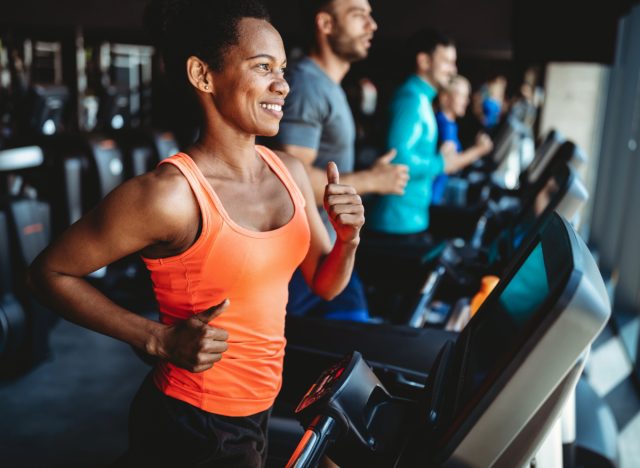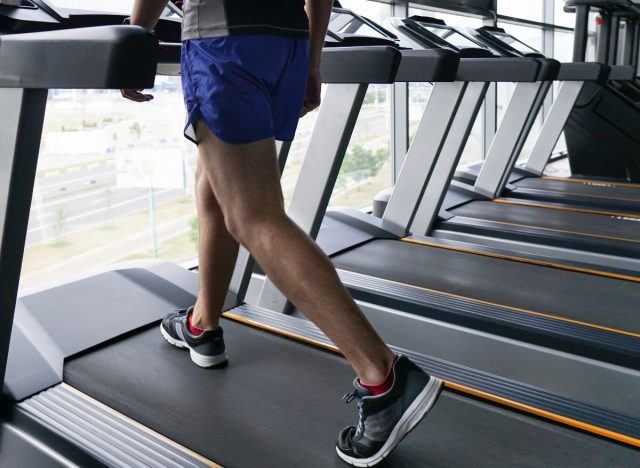The top cardio equipment for fat loss, as recommended by a specialist.
Treadmills, ellipticals, stationary bikes, rowing machines—you might think these exercise tools offer the same benefits, but not all cardio machines are created equal when it comes to losing weight. Choosing the best cardio machine for weight loss and your personal preferences can make a world of difference in your journey by keeping your cardio sessions fun and enjoyable. This way, you can stay consistent in the long run, which studies indicate is essential for healthy, sustainable weight loss.
But with countless options available, it can be difficult to find a cardio machine that fits your goals and keeps you motivated. That’s why we talked to Chris Mohr, PhD, RDan exercise physiologist and fitness and nutrition advisor for Fortune Recommends, who reveals his recommended cardio machine to melt body fat and boost your health.
Research consistently shows that regular cardio is essential for weight loss and improving overall health. According to Johns Hopkins Medicineaerobic activities such as brisk walking, running, swimming and cycling help increase your heart rate, burn calories and increase metabolism, all of which are important components in shedding unwanted pounds.
But different cardio machines offer more benefits (and potential drawbacks) than others for weight loss. Below, Mohr reveals his top recommended cardio machine for weight loss that can change your workout routine.
The best cardio machine for weight loss

You can’t beat the classic treadmill when it comes to killer cardio machines for weight loss. A 2021 study in Journal of Sports Science & Medicine found that treadmills are the most effective method of burning fat during exercise compared to ellipticals and rowing machines. This is likely due to the treadmill’s versatility, which allows you to combine walking, jogging and running to keep your sweat sessions fun and challenging.
“Treadmills are great for weight loss because they’re versatile enough to work for all fitness levels, from beginners to advanced users,” explains Mohr. “Its ease of use to adjust both incline and speed makes it ideal for increasing exercise intensity over time, which is useful for sustainable weight loss, but of course it’s not independent of resistance training and a generally healthy diet.”
Some treadmills allows you to simulate different terrains, adding variety to your workouts. This feature can help you stay engaged while training your body for real-world activities like hiking or running outdoors.
Treadmill benefits beyond weight loss


“Using a treadmill helps expend more energy, which is necessary for weight loss and maintenance,” says Mohr. “It increases your heart rate and improves cardiovascular health; many benefits are independent of body weight. The ability to change settings to simulate different terrains and do interval training also helps increase your energy expenditure. Treadmills often have digital monitors that show your progress, such as distance and time, which can help you stay motivated by seeing your achievements.”
Treadmills raise your heart rate, which a study from 2019 suggests can help strengthen your heart and lungs for better cardiovascular health. Research shows that improved cardiovascular health is essential for overall well-being and can reduce the risk of chronic diseases, including heart disease and diabetes.
Using a treadmill for interval training can provide even more health benefits. Studies suggests that alternating between periods of high-intensity running and active recovery (walking) can improve cardiovascular fitness and calorie burning.
In addition, most treadmills have built-in digital monitors. These monitors provide valuable feedback on your exercise progress, such as distance covered, exercise time and calories burned.
Other considerations when using a treadmill


While treadmills are generally safe and effective for most people, Mohr says there are some exceptions. “Treadmills are generally safe for most people, but they may not be best for those with knee, hip or lower back problems,” he says. “The impact generated by walking or running on a treadmill can potentially exacerbate existing joint problems, making it critical to assess your health conditions before starting a treadmill program.”
For those who may experience discomfort on a treadmill, consider trying lower-impact cardio machines, such as ellipticals or stationary bikes, which still provide a solid cardiovascular workout with less impact on the joints.
Get started on the treadmill


If you’re ready to incorporate more treadmill exercise into your exercise routine, be sure to start gradually. For beginners, start with a combination of walking and light jogging, aiming for 20 to 30 minutes per session. As you build endurance, you can gradually increase the intensity by adjusting the speed and incline settings.
Ultimately, achieving long-term weight loss and increasing fitness requires consistency, a balanced diet, and strength training. As always, talk to your health care provider or a certified fitness expert before starting a new exercise plan or trying new cardio equipment.

